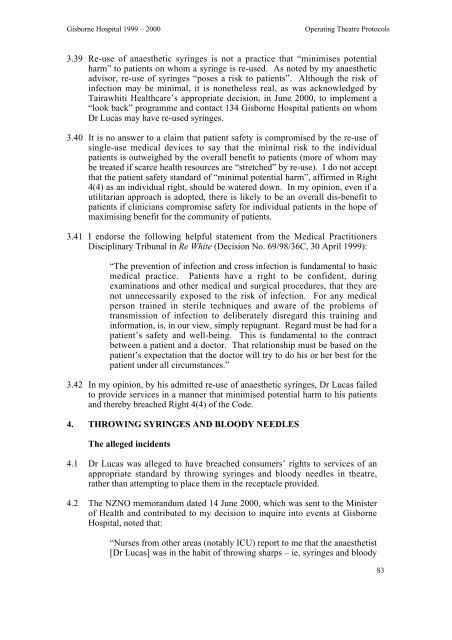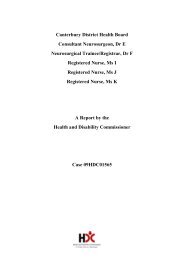Gisborne Hospital Report - Health and Disability Commissioner
Gisborne Hospital Report - Health and Disability Commissioner
Gisborne Hospital Report - Health and Disability Commissioner
Create successful ePaper yourself
Turn your PDF publications into a flip-book with our unique Google optimized e-Paper software.
<strong>Gisborne</strong> <strong>Hospital</strong> 1999 – 2000<br />
Operating Theatre Protocols<br />
3.39 Re-use of anaesthetic syringes is not a practice that “minimises potential<br />
harm” to patients on whom a syringe is re-used. As noted by my anaesthetic<br />
advisor, re-use of syringes “poses a risk to patients”. Although the risk of<br />
infection may be minimal, it is nonetheless real, as was acknowledged by<br />
Tairawhiti <strong>Health</strong>care’s appropriate decision, in June 2000, to implement a<br />
“look back” programme <strong>and</strong> contact 134 <strong>Gisborne</strong> <strong>Hospital</strong> patients on whom<br />
Dr Lucas may have re-used syringes.<br />
3.40 It is no answer to a claim that patient safety is compromised by the re-use of<br />
single-use medical devices to say that the minimal risk to the individual<br />
patients is outweighed by the overall benefit to patients (more of whom may<br />
be treated if scarce health resources are “stretched” by re-use). I do not accept<br />
that the patient safety st<strong>and</strong>ard of “minimal potential harm”, affirmed in Right<br />
4(4) as an individual right, should be watered down. In my opinion, even if a<br />
utilitarian approach is adopted, there is likely to be an overall dis-benefit to<br />
patients if clinicians compromise safety for individual patients in the hope of<br />
maximising benefit for the community of patients.<br />
3.41 I endorse the following helpful statement from the Medical Practitioners<br />
Disciplinary Tribunal in Re White (Decision No. 69/98/36C, 30 April 1999):<br />
“The prevention of infection <strong>and</strong> cross infection is fundamental to basic<br />
medical practice. Patients have a right to be confident, during<br />
examinations <strong>and</strong> other medical <strong>and</strong> surgical procedures, that they are<br />
not unnecessarily exposed to the risk of infection. For any medical<br />
person trained in sterile techniques <strong>and</strong> aware of the problems of<br />
transmission of infection to deliberately disregard this training <strong>and</strong><br />
information, is, in our view, simply repugnant. Regard must be had for a<br />
patient’s safety <strong>and</strong> well-being. This is fundamental to the contract<br />
between a patient <strong>and</strong> a doctor. That relationship must be based on the<br />
patient’s expectation that the doctor will try to do his or her best for the<br />
patient under all circumstances.”<br />
3.42 In my opinion, by his admitted re-use of anaesthetic syringes, Dr Lucas failed<br />
to provide services in a manner that minimised potential harm to his patients<br />
<strong>and</strong> thereby breached Right 4(4) of the Code.<br />
4. THROWING SYRINGES AND BLOODY NEEDLES<br />
The alleged incidents<br />
4.1 Dr Lucas was alleged to have breached consumers’ rights to services of an<br />
appropriate st<strong>and</strong>ard by throwing syringes <strong>and</strong> bloody needles in theatre,<br />
rather than attempting to place them in the receptacle provided.<br />
4.2 The NZNO memor<strong>and</strong>um dated 14 June 2000, which was sent to the Minister<br />
of <strong>Health</strong> <strong>and</strong> contributed to my decision to inquire into events at <strong>Gisborne</strong><br />
<strong>Hospital</strong>, noted that:<br />
“Nurses from other areas (notably ICU) report to me that the anaesthetist<br />
[Dr Lucas] was in the habit of throwing sharps – ie, syringes <strong>and</strong> bloody<br />
83
















